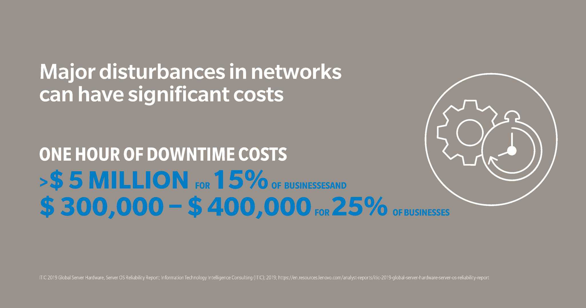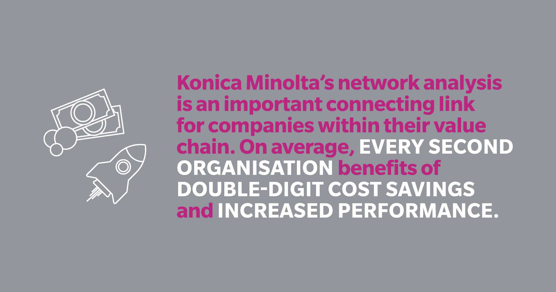Whatever the size of a business or industry sector, its IT network is its cardiovascular system. This analogy highlights the paramount importance of its all-encompassing presence in the organisation, with any disturbances being able to have critical – potentially business-threatening – implications. However, also like the cardiovascular system, efficiency in operation is essential. In this case not ‘the bigger the better’ counts, but flexibility and perfect adaptation to tasks at hand. Lean, yet powerful enough to handle different levels of stress and even potential shocks. With networks, these flexibility and adaptability requirements are growing: increasing global competition and ever more complex IT systems even for small and medium-sized businesses together with growing market volatility all add to this challenge – making well-working IT networks absolutely mandatory. Ensuring an organisation is running a suitable network requires experts with the knowledge of IT systems in general and of their actual real-life requirements in order to monitor the network and draw the right conclusions. Continuous monitoring, comparable to a long-term ECG for the network, makes it possible to detect potential problems and flexibly adapt systems to actual requirements. This helps to shape the system based on empirical evidence combined with know-how. As a specialist in managed IT-services, Konica Minolta unites both empowerment of its customers with a tailored and reliable network – ensuring it is able to fulfil its core tasks as a strong information system of the organisation and its business needs.
The underestimated costs of a sub-optimal network set-up
The consequences of running a sub-optimal network can be roughly divided into two categories: direct ones with immediate consequences for the organisation and indirect consequences that translate into negative effects on efficiency and operational costs. Direct consequences are felt immediately throughout the organisation: “When it comes to appreciating the importance of an IT network, the dilemma is that it is virtually invisible in daily workflows when everything is working smoothly. Most parts of the organisation, especially those outside the IT department, only become aware of its importance when it is not working as it should. And then it quickly becomes a painful realisation,” says Kieron McDonald, ITS Business Development Manager at Konica Minolta Business Solutions (UK) Ltd., on the challenges of running IT networks. With its key role as the information grid inside the organisation, the IT network is an essential element when it comes to efficiency in the company – seamless operation is crucial to ensure processes run smoothly.

Nevertheless, the importance of a well-functioning network is quickly underestimated – major disturbances in networks for various reasons can have significant costs, from reduced workforce efficiency to a threat to a company’s existence if the system breaks down or is unavailable for an extended period of time. These costs are substantial. The results of a survey from ITIC show that the costs of such interruptions can have a serious impact on a company’s finances: for example, 25% of the respondents indicated that one hour of downtime cost them between USD 300,000 and USD 400,000, while 15% reported a loss of more than USD 5 million per hour.[1] The indirect costs are more subtle. However, with a long-term effect on an organisation’s efficiency and therefore profitability not any less important to take into consideration, non-optimal networks can drive both capital and operational expenditures. No wonder, therefore, that monitoring network performance is high on the priorities list of IT decision makers in EMEA: 38% intend to monitor network performance.[2]
Network optimisation will become even more important in the future. With the continuous digitalisation of business processes, ever more systems, mobile devices and IoT solutions are becoming integral parts of the network, thus increasing the complexity of the network. Big data and cloud-based services are further driving complexity and adding to network traffic. After all, applications and data are no longer just present in their own data centre, but also at cloud providers, service providers or on employees’ mobile devices.
Continuous monitoring for an optimised network
Constant observation of the entire network is an important basis to ensure its adequacy, to determine the performance through network analysis and to safeguard it through subsequent adaptation measures. As a first step, a one-off analysis can help to determine the status of a network. In many cases, however, this is too short, because temporary load peaks may not be detected. Seasonal peaks occur such as end-of-month billing, an extensive ordering process at the beginning of the production phase, a retailer’s pre-Christmas season or even the summer travel period for a tourism company. If these peaks are not taken into account in the network analysis, the measures derived from them will not cover actual customer requirements.
Therefore, a far better approach is long-term, ideally even constant, monitoring of the network. IT analysis of the entire system conducted over an extended period captures phases with peak loads as well as other, non-everyday events, e.g. employees may not always connect their mobile devices to the corporate network. This means that even different locations such as a home office, a customer’s premises or a train compartment can provide valuable insights for the Internet connection. The use of cloud applications, which is customary today, can also be observed over an extended period, since there are often different utilisation levels. As can be seen, only corresponding long-term monitoring allows for a realistic evaluation of the systems.
Based on long-term, comprehensive monitoring, targeted measures can be developed and implemented that provide real added value for the company. “Continuous monitoring creates far more valuable – even real-time – insights. The effort to install such a monitoring system is practically the same, whether for a short-term or long-term ECG, but it makes the difference for diagnosing the status of the network. The data is collected automatically, so there are virtually no costs. And the subsequent evaluation also involves the same amount of effort, whether the data cover one day or a whole year. Of course, the amount of data is different, so the analysis has to be done with appropriately dimensioned systems. But in the age of the cloud, this is no longer a problem. The long-term approach gives the company significantly more reliable information about the performance and bottlenecks of the systems,” says Kieron McDonald, explaining the holistic approach necessary for a proper functioning network.
The right set-up with the right partner
To achieve the aim of a reliable network, its performance needs to be reviewed using network analysis and, depending on the findings, adaptation measures have to be taken. This requires strong expertise and specialist knowledge to evaluate and adapt real-life IT environments.
Choosing the right partner for these tasks is challenging. Some providers only install standard monitoring software and after two days give quite general recommendations. Instead, an organisation should find a partner with a proven track record in the subject and a holistic approach with expertise in fields related to networks such as infrastructure applications and security. After all – exploiting synergies and performing optimisation that meets the challenges of data growth, security and recovery, Internet connectivity and resilience, cloud and mobile solutions can best be achieved by a full-service provider. Beyond the narrow technical solutions and skill sets, it is paramount to have a partner that can provide comprehensive consulting services and who understands the business field and processes of the organisation.
“Only a partner that truly comprehends an organisation’s business and workflows can interpret the results of the monitoring properly and draw the necessary conclusions. They need to consider the critical junctions in the processes. Where will the business evolve and what network resources are needed for this?” summarises Kieron McDonald. This ensures that not only monitoring is performed accurately, but also that the outcomes are applied correctly.
The state of the network – valuable insights through in-depth analysis:
In its practical application, Konica Minolta’s customers can see the benefits such a process provides first-hand. “In general, our customers already have a rough idea of the limitations and challenges their networks face. Reoccurring network problems, outdated infrastructure, opaque operational costs or seasonal bottlenecks are examples of what drives them to seek our support,” explains Kieron McDonald. For the analysis, Konica Minolta develops a tailored set-up, matching the customers system and requirements. “The clear goal here is to identify their true problems or suboptimal resource allocations, and hence optimisation potential, on a quantified, fact-based level,” McDonald elaborates. The potential Konica Minolta identifies are frequently quite significant – on average, every second organisation enjoys double-digit cost savings and increased performance.
With their unique, comprehensive experience in different industries and with various sizes of company, Konica Minolta’s experts thoroughly understand the factors crucial for the customer – and focus on those with great weight when it comes to optimising their network. Hence, their first question to the customer is not: ‘What solutions do you want us to implement?’ but rather: ‘What do you need or want to achieve with your network?’ This approach provides them with a better understanding of the parameters and performance indicators truly important to the customer. Based on this information, Konica Minolta runs its dedicated in-depth analysis of the strengths and weaknesses, be it in a short- or long-term evaluation.

Here, it is very helpful that Konica Minolta does not conduct the process of network analysis as a discrete project. Rather, the analysis is combined holistically with its array of IT services. This means that after the analysis of the network has been performed, customers are not left alone with the results. Instead, they receive a comprehensible interpretation of the insights and a dedicated action plan with guidance on the outcomes and suggestions for suitable system amendments.
“We set up our network analysis services in a way that offers our customers the basis to guide their existing resources in the direction where they function best and most efficiently,” explains Konica Minolta’s ITS Business Development Manager. “Konica Minolta’s network analysis thus becomes an important connecting link for customers within their value chain.”
The optimum network – provided by Konica Minolta
“We understand that, in order to be optimal, every network has to be unique, as it has to meet unique challenges. Our approach to network analysis is therefore not ‘one size fits all’: instead, we accompany the customer on their path to their ideal network setup,” Kieron McDonald concludes. With its holistic, customer-centric approach to network analysis, Konica Minolta provides customers with the best possible solution based on their requirements and constantly supports them – the right partner to future-proof their customers’ IT network.
[1] ITIC 2019 Global Server Hardware, Server OS Reliability Report; Information Technology Intelligence Consulting (ITIC); 2019; https://en.resources.lenovo.com/analyst-reports/itic-2019-global-server-hardware-server-os-reliability-report
[2] IT Priorities 2019: Security concerns top agenda for network buyers again; Computer Weekly/TechTarget; 2019; https://www.computerweekly.com/news/252458119/IT-Priorities-2019-Security-concerns-top-agenda-for-network-buyers-again



